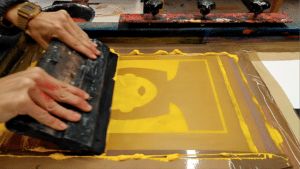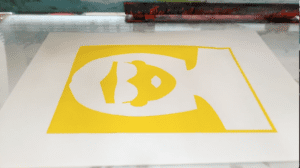
Screen printing applies color to a support (paper / textile) with the help of a squeegee that passes ink through a fine mesh or screen.
Let's talk about the serigraphyIt is a very simple technique that can be done at home with the necessary materials. To understand a little better what it is about, we will do a brief review of some more theoretical concepts.
What is screen printing?
Screen printing is a manual stamping method that allows us to transfer traced images through a mesh called screen, is impregnated with ink on the surface to be printed. For each color that you want to print, we need an additional screen, that is, it works through layers.
We could say that it is one of the oldest techniques, although it is not attributed to any author or inventor. The Egyptians and the Chinese were great forerunners of this way of stamping, and today, it is one of the most popular stamping techniques in the world due to its simplicity and low cost. At present it has been modernized with machinery, therefore, the process is much faster.
Origin of the word
The word serigraphy is of Latin origin «sericum» (silk) and Greek «graphè» (act of writing, describing or drawing), this combination of words can be called «silk screen». Therefore, screen printing is the technique of drawing or writing through silk for commercial, industrial or artistic applications.
Standard procedure
Next we are going to list the order in which the screen printing technique is carried out. The steps are the following:
- First of all, we must do the design realization.
- Printing of the design on the polyester sheet.
- Photolith result.
- Plate emulsion.
- Insolation of the photolith on the plate.
- Clean up the excess, we will probably need to have a roll of paper on hand.
- Tape the contours of the plate.
- Carrying out the registration is undoubtedly essential to frame the design.
- Impregnate the plate with the ink (charge).
- Finally, the printing is carried out on the desired support.
